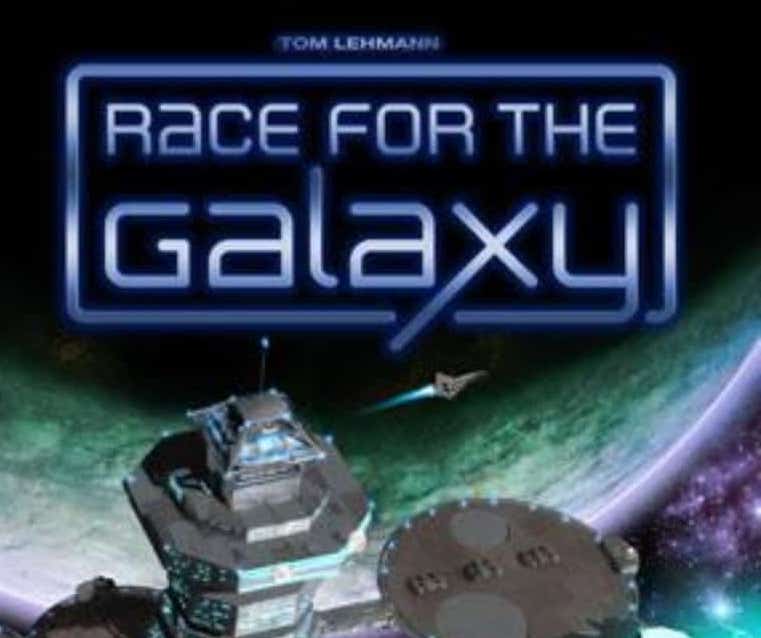Race for the Galaxy (Rio Grande Games, 2-4 players, ages 12+, 30-60 mins) is a card game of space exploration and exploitation that challenges players to develop the best space empire they can using a variety of methods. The object of the game is to score the most Victory Points by the game’s end.
How the Game is Played
The game’s main mechanics are action selection and tableau building. Each player begins the game with a randomly chosen homeworld that begins their tableau, and a set of 7 action cards. The action cards, each set of which is identical, are used to determine which of the game’s five phases will be played that turn. This is an interesting idea, as while there are 5 potential phases in a game turn, not all of them will actually take place. Additionally, 12 victory point chips are placed into a central supply for each player in the game. Players will take chips from this pool as they earn victory points during the game.
Each player starts with a handful of cards randomly drawn from a shared central deck. Cards in this game have multiple uses. They can be played into a player’s tableau, where they can provide resources, victory points, and special actions. Each card has a cost associated with playing it. This cost must be paid for by discarding cards from hand into a central discard pile. Cards thus are also a form of generic currency. The third use cards have is as goods that are placed face-down on planet cards in a player’s tableau. These goods can then be used to power actions or traded in for victory points.
The game’s 5 phases are, in order, Explore, Develop, Settle, Consume, and Produce. At the start of each turn each player secretly selects one of his 7 available action cards and places it face-down on the table. All cards are then simultaneously revealed and the turn’s phases then begin. Only those phases that at least one of the players has chosen as his action card will happen during the turn. Two of the phases (Explore and Consume) have two cards associated with them that offer different bonuses during that phase. When a phase does occur, all players will get to take actions during that phase, with the player(s) who chose that phase with their action card getting a special bonus during that phase. These bonuses may reduce the cost of playing a card, or allow an extra card draw depending on the phase.
The Explore phase allows players to draw cards into their hands, one of the only ways to replenish their supply of cards. The Develop and Settle phases are similar in nature. They allow players to place one development or planet card, respectively, into their tableau, paying the appropriate cost by discarding cards from their hand. Consume lets players discard goods cards from planets in their tableau to take consume actions. These actions, available on planets and developments in their tableau, give players the chance to trade their goods for victory points or other benefits. Finally, the Produce phase causes all planets in a player’s tableau that are able to produce goods (and don’t already have a goods card on them) to do so, by taking a card from the draw deck and placing it face down on that planet.
After all phases that were chosen by players are finished, each player takes the action card they played that turn back into their action card stack and a new turn begins. Play continues until one of the game’s end conditions are met: any player has 12 or more cards in his tableau, or the victory point supply pool is exhausted. Each player calculates his victory point total from his chips and on cards in his tableau, and the player with the most victory points is the winner.
Observations and Conclusions
Race for the Galaxy looks intimidating at first glance. The amount of iconography on the cards appears overwhelming and gives the impression that half the game will consist of looking up various icons on player aid sheets. This impression is false, however, as Race for the Galaxy is actually a very simple game and the icons are rather intuitive. The strategy of the game is anything but simple, however. This is a very deep game with lots of choices to make each turn. The choice of which action card to play is always interesting, as it ensures that a phase will occur that turn and playing the card provides a bonus, but it also means that all the other players will be able to act during that phase. This means that other players may benefit equally, or even greater, than the player that chose the phase. Balancing cards in hand is difficult and provides tough choices as to which card to play and which cards to discard to pay for it. The large number of cards, and the fact that all discards are face-down, lends the game tremendous replayability, and this is a game that demands multiple plays to explore the many different strategic options it offers.
While Race for the Galaxy definitely fits firmly into the Eurogame category its theme comes through much more strongly than expected for that game group. The computer artwork on the cards evokes the feeling of an old-style Isaac Asimov space empire, and the iconography works here in the game’s favor as it lends the cards a futuristic look. The drawing and choosing of cards feels like searching through space to find the next planet or scientific discovery, hoping for that particular one needed to create a nice engine in a tableau.
Race for the Galaxy is a new “classic” in a sense. It immediately feels fresh and different and just begs for repeated plays. A rare Eurogame that has an evocative theme, it stands out among the many, many new releases that come out fast and furious seemingly every week. There is plenty of room for expanding the base game. In fact, a number of expansions have already been released. These expansions not only add new cards to the game, but also expand the number of players and offer a solid solitaire option. Race for the Galaxy has even spawned a dice version, titled rather amusingly, Roll for the Galaxy as well as a board game version and Jump Drive, a fast and furious version of the base game. Rio Grande Games have created a new “universe” of games to go along with their success of Dominion, and like that earlier game Race for the Galaxy is a solid design that deserves to be in every gamer’s collection.
SCORE
9.0
REVIEW
Buy9

